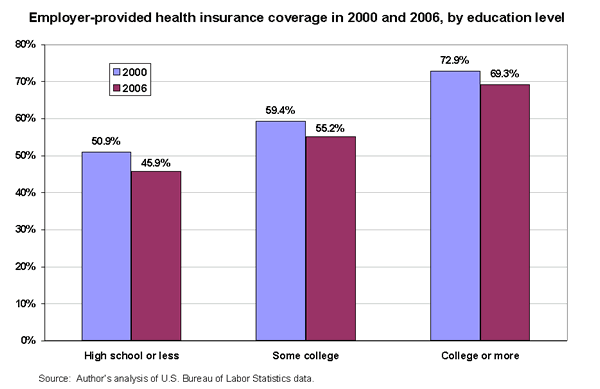See Snapshots archive.
Snapshot for April 16, 2008.
Health insecurity across education levels
It is widely recognized that the employer-based health care system is eroding. The share of workers with employer-provided health insurance has decreased substantially in recent years, even amidst relatively low levels of unemployment and growing productivity. From 2000 to 2006, the share of workers who received health insurance from their own jobs declined 4 percentage points.1
Perhaps surprisingly, the decline in coverage has taken place across the entire age, education, occupation, industry, race, and ethnicity spectrum. As an example, the chart below shows the decline in employer-provided health insurance between 2000 and 2006 for workers with different levels of education. While workers with more education are more likely to receive health insurance from their employers, workers from all education levels have seen similar declines in coverage. Specifically, workers with no more than a high school education saw a decline of 5.0 percentage points, workers with some college education but no bachelor’s degree saw a decline of 4.2 percentage points, and workers with a college degree or more saw a decline of 3.6 percentage points. Overall, 6.4 million fewer workers had employer-provided health insurance in 2006 than in 2000.
These findings, along with others in the Economic Policy Institute paper A Decade of Decline, show that health insecurity is now a broadly shared American experience. The erosion at all levels of the employer-based system, along with the critical need to control skyrocketing health care costs, indicate that the time has come to reform our health care system to guarantee that all Americans have access to affordable, high-quality health insurance. The Health Care for America plan, for example, would ensure that all Americans receive coverage and would do so at a lower total national cost than the current system.
Note
1. Includes private-sector wage and salary workers age 18-64 who work at least 20 hours per week and 26 weeks per year. Employer-provided health insurance is defined here as receiving health insurance through one’s own job, where the employer pays at least part of the insurance premiums.

